|
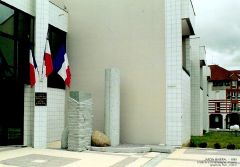 |
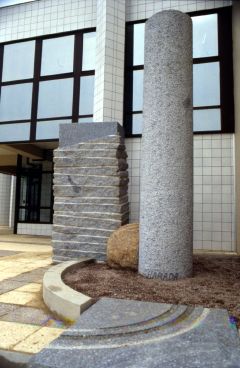
|
_ This is a
sculpture to which I gave two names and two meanings: “Signal”
et “Haniwa”. From a French point of view, it mostly has
a signposting function.
In Japanese, though, “Haniwa” is a funerary object that existed
before 2000 BC, a stele, an object close to the heart of
a noble people.
_ この作品には、2つの違う意味のタイトルを付けました。「目印」と
「埴輪」です。フランス人にとっては特に標の機能を示し、日本語では、紀元前2000年前以来存在する焼き物で、尊い家系墓への供え物としての「埴輪」の神秘的な意味合いを持たせました。
_ C’est une sculpture à laquelle j’ai donné deux noms
et deux significations: «signal» et «haniwa». Pour un regard
français, elle a surtout une fonction signalétique.
En japonais «Haniwa » désigne un objet funéraire qui existe
depuis avant -2000 av JC, une stèle, un objet qui est cher
à des gens nobles.
|

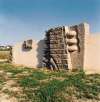
|
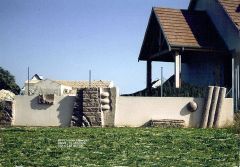 |
_ This private commission
(on the right) marks the entrance to an allotment, to give
a more distinct identity to the place.
> You mean you gave your personal artistic identity?
_ Not really. The architecture already had an identity but
this work gives the allotment something unique.
_ このプライベートの注文作品 (右) は、建物のアイデンティティを与えるために、団地の入り口に作りました。
> あなたの個人的アイデンティティを記したと言うことですか ?
_ と言う訳ではありません。建築自身にすでにアイデンティティがあります。しかし、この作品は他にない何かをこの団地にを与えているのです。
_ Cette commande privée (à droite) a pour fonction de
marquer l’entrée d’un lotissement, donner une identité
au lieu.
> En fait tu as donné ton identité personnelle ?
_ Pas vraiment, l’architecture avait déjà une identité,
mais ce travail donne au lotissement quelque chose que
les autres n’ont pas.
|
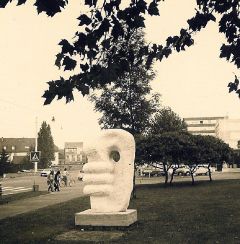 |
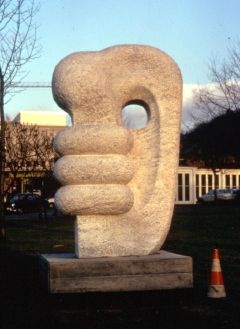 |
_ Those sculptures express a political commitment.
(Left) In Germany “la main de Bouddha” (the “Hand of Buddha”).
I came from Japan to a West Germany divided by a wall.
I wanted to send a message of peace through a religious
character, a universal and serene message of wisdom.
(down)
In Spain “la mano de la Paz” (the “hand of peace”), a
closed hand, a fist banging down on the table, I was
despite against Franco. Another way to talk about peace.
_これらの彫刻は社会問題に参加するものです。
(左上)ドイツ「仏の手」。私は、日本からまだ壁があったドイツに行きました。「仏」と言う聖人を通して、普遍概念と穏やかな平和メッセージを理解して欲しいと願いました。
(左下)スペイン「平和の手」。閉じた手で
テーブルの上を拳でドンと叩いている 。私はフランコに対して怒りを感じていました。これは平和を語るもう一つの方法です。
_ Ce sont des sculptures engagées.
(haut) En Allemagne de l’Ouest, «la main de buddha», j’arrivais
du Japon en Allemagne était encore divisée en deux.
Je voulais passer un message à travers un personnage religieux,
un message serein et universel de sagesse.
(bas) En Espagne,
« La mano de la paz », la main fermée, «taper du poing
sur la table», j’étais en colère contre Franco. Une autre
manière de parler de la paix.
|


|
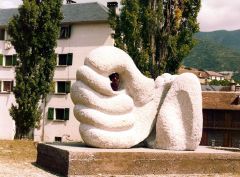 |
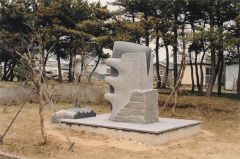
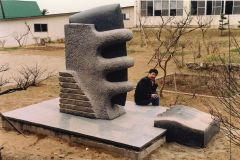 
|
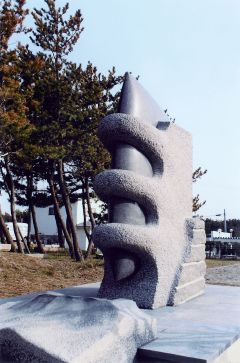
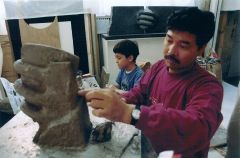
|
> This sculpture is inside
a retirement home. I think I recognize the traces of hands
on the smaller elements ?
_ These result from fingers pressed on the stone. The hand
can have numerous meanings: power, strength, softness, friendship,
commitment, sharing... Elderly people need a hand as a guide
and support in the twilight of their life. This is a sentimental
sculpture.
> この彫刻は、特別養護施設の庭にあります。作品の表面に指の跡のようなものが見られますが
?
_ これらは、そこに置かれ、押された指の跡です。手は、権力、力、柔らかさ、友情、関与、分かち合い等 多くのシンボルを持ちます。
老人は人生を全うする為に導いてくれる手が必要です。これは、感傷的な彫刻です。
> Cette sculpture est installée dans une maison de
retraite. Je crois reconnaître des traces de doigts sur
l’élément?
_ Ce sont des doigts appuyés, posés. La main peut symboliser
beaucoup de choses, le pouvoir, la force, la douceur, l’amitié,
l’engagement, le partage... Les gens âgés ont besoin d’une
main à laquelle se tenir pour finir la vie. C’est une sculpture
sentimentale.
|
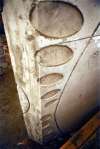

|
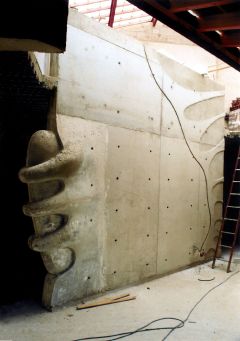 |
> More hands ?
_ No, these are pregnant bellies. It is actually part of
the building, melded into the concrete. The work is in
the waiting room of a hospital, I wanted to represent
protection of children, the egg.
>これも手ですか ?
_ いいえ、これは手ではなく、お腹を抱えている様子です。型枠の中に直接セメントを流し込んで、完全に建物の一部分となっています。これは病院の待合室にあります。私は子供、卵の保護を表わそうとしました。
> Encore des mains ?
_ Non, celles-ci ce ne sont pas des mains, ce sont des
ventres qui portent. C’est coulé dans la masse du béton
par coffrage, ça fait vraiment partie du bâtiment.C’est
dans la salle d’accueil d’un hôpital, je voulais représenter
la protection de l’enfant, l’oeuf.
_ Like a hand taking a
tool, sending back to a time when man started using tools.
_ 道具を使い始めた頃を思わせる、一つのオブジェを握る手。
_ Comme une main qui prend un oobjet pour
évoquer le début de l’age de l’outil.
|

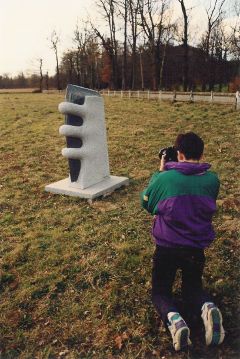 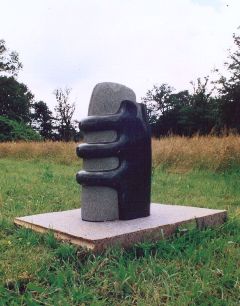
|
_ This is a protected earth,
like an egg. It’s a fragile and defensive sculpture.
_ 卵のように、保護された地球です。もろくて防御的な彫刻です。
_ C’est la terre protégée, comme un œuf. C’est une sculpture
fragile et défensive.
_ Here it is more like an armour, the polished parts being
inside.
_ これはむしろ、鎧です。磨かれている部分は内側にあります。
_ Là ce serait plutôt une armure, ce qui
est poli est à l’intérieur.
_ These are hands protecting
what is incubating inside. The polished part is outside,
usually what is polished is felt to be more fragile, sensitive.
_ これは、内側で起ころうとしている何か、一つの孵化を保護する手なのです。磨かれた部分は外にあります、通常、磨かれた部分はより傷つきやすくより繊細に感じるものです。
_ Ce sont des mains qui protégent quelque chose qui se
prépare à l’intérieur, une incubation. Ce qui poli est
à l’extérieur; en général on sent ce qui est poli comme
plus fragile, plus sensible.
|
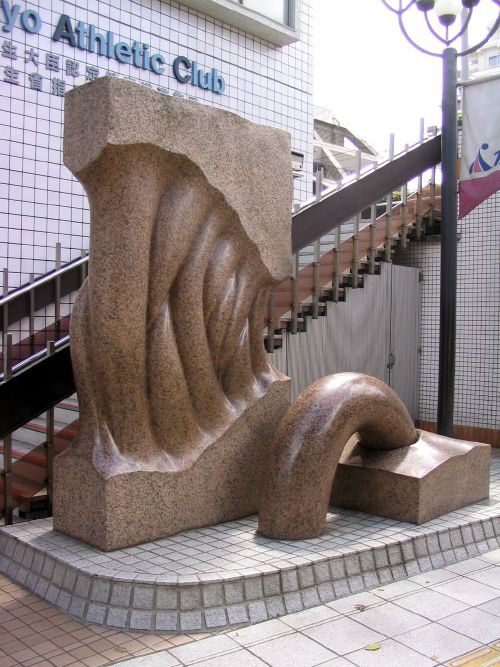
|
_ This is a commission for
a gymnasium in Tokyo that wanted to signal itself (on the
left). I wanted to talk about strength, movement to show
man’s energy. The shape, the colour, the material: all
these elements create the feeling of seeing a muscle. It
is a very simple answer and from my point of view, a success.,
The space was tiny, it was a challenge.
A ring puts the sculpture in the continuity of the global
Earth Weaving idea.
_ これは、記念碑的目印を要望した、東京都内の体育館のための注文作です(左) 。私は力強さ、躍動、人間のエネルギー等を表現したかった。形、色、素材、これらは確かに筋肉です。
非常に単純な答えです。そして、私から見れば、この作品は成功したと思います。それはスペースが狭く、大変な挑戦でした。
リングは、この作品が「地球を縫う」彫刻の一連のアイデアに属している事を思わせます。
_ C’est une commande pour une salle de gymnastique à Tokyo
qui désirait se signaliser (à gauche). Je veux parler de
la force, du mouvement, montrer l’énergie de l’homme. La
forme, la couleur, la matière : c’est vraiment un muscle.
C’est une réponse très simple et je pense que c’est un
succès, il y avait peu d’espace, c’était un challenge.
Un anneau rappelle l’appartenance de cette sculpture à
l’idée globale du Tricot de la terre.
|
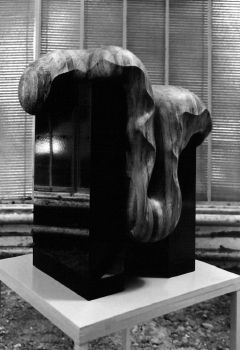
|
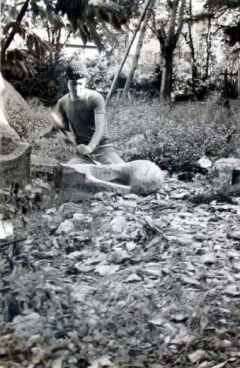 |
_ Wood is a very docile material which
allows you to obtain very refined structures and lines.
I worked the surface of the wood, creating a rough and
tense feel, using traces of chisle. The first impression
is that of a muscle, but it isn’t one. These are roots,
an image of vegetal tension. When you observe you can see
that the energy is not the same, the idea is different.
In fact, the two ideas are quite the opposite: in a muscle
there is an inward force, here the force is outward.
I often hesitate when I have to name a sculpture. You know,
it may not be necessary that I explain so much. Maybe some
of the value of the sculpture is in the mystery, in the
fact that its meaning can be found and can change according
to the interpretation of each person; different intimacies
creating different meanings. This is why the value of my
explanations is limited, and could even be forgotten.
_ I am a sculptor, not a writer, and what I have to say
is in the shape, my liberty ends once the shape is created,
the liberty of the audience starts with that shape and
it may lead it as far as its imagination will allow. I
do not wish my explanations to interfere with each person’s
perception of the sculpture. My work touches people’s soul
in different ways, and this is a good thing.
_ 木は非常に従順な材料ですから、結構細かな構造の処理をすることができました。そして、ノミ跡を残すことにより、緊張させたり、ざらざらした表面を作りました。筋肉に似ているかもしれませんがそうでなく、これは植物の根っこ、植物の緊張感です。よく見てもらうとそれが同じエネルギーでないのが分かると思います。むしろ反対のアイデアです。筋肉には圧縮感があるのに対し、ここでは、分裂感があります。
度々何と言うタイトルにするか迷う事があります。
そう、たまには私がそれほど説明する必要がないみたいです。見る人それぞれが個人的な解釈をすることに、彫刻の秘められたある価値観がある様です。
だから私が説明している事は、忘れてもいいことなのです。 私は彫刻家で物書きではありません。そして、私が言いたい事は作品の中にあります。私の自由は形をつくる事で終わり、そこから見る人の自由で限りない想像が始まるのです。
私の説明が見る人の解釈を妨げないことを望みます。私の作品で見る人がその精神の中で幾分異なるものを呼び起こすことが出来れば、とても嬉しく、それに越したことはありません。
_ Le bois est un matériau docile qui m’a
permis la finesse des structures. J’ai travaillé le bois
en donnant une surface tendue et rugueuse avec des traces
de gouge.
Malgré la ressemblance, il ne s’agit pas d’un muscle, il
s’agit de racines, de la tension végétale.
Quand on observe, on sent qu’il n’y a pas du tout la même
énergie, ce n’est pas du tout la même idée, c’est même
l’opposé, dans le muscle il y a compression, ici il y a
écartèlement.
Souvent, je ne sais pas quoi donner comme nom. Tu sais,
il n’est peut-être pas nécessaire que j’explique autant,
peut-être que la sculpture peut trouver une certaine valeur
dans le mystère, dans le fait qu’elle est signifiante dans
l’intimité de l’interprétation de chacun.
Alors, la valeur de mes explications est à tempérer, à
oublier.
Je suis un sculpteur, pas un écrivain, ce que j’ai à dire
se trouve dans la forme, ma liberté s’arrête à créer une
pièce, celle du public commence à la forme pour l’emmener
aussi loin qu’il le souhaite. Par mon discours, je souhaite
ne pas nuire à l’interprétation de chacun, ma sculpture
éveille quelque chose de différent dans l’esprit de chacun
et je m’en réjouis.
|
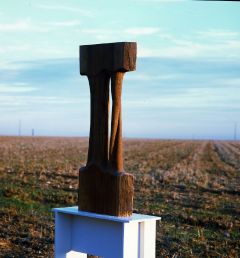 |
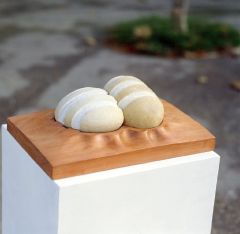 |
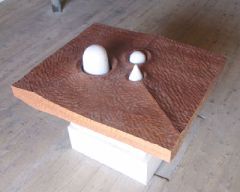 |
 |
|
|
| |
|
| |
|
| |
|
|
|